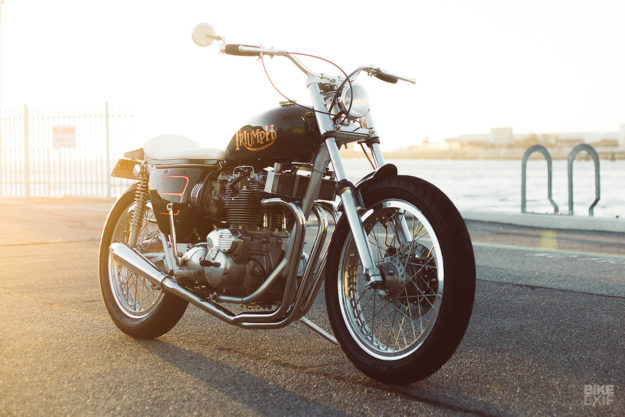
The torque of a twin, the top end power of an inline four, and the sound of angry bees. What’s not to like?
Rob Glenton of Fremantle, Western Australia has a penchant for old British bikes. So when a solid condition 1973 T150V Trident presented itself, he jumped at the chance to relive his younger years on a classic Triumph triple restomod.

“I’ve always liked the triple: they are so different to the twins, and custom examples are very rare. The sound of a bike is as important to me as the looks, and the triple has a fantastic sound, especially with a 3-into-1 pipe. The sound is often likened to that of a classic race car.”
Taking inspiration from the world of flat track racing and Evel Knievel’s steeds, Rob tore into the Trident, starting with the basic lines.

“I wanted the bike to have presence,” says Rob. “A stance. Like a speedway bike with the rider hunched over the bars waiting for the tape to lift. Or Kneivel showboating on his Sportster jump bike.”
The tank is standard but Rob had local fabrication wizard Tom Sharman of Sideshow Cycles chop 40mm from the middle, for a lower profile and a racier silhouette. Tom also built the flat track tail unit to Rob’s specifications and modified the rear loop to suit. The tail lifts off using repurposed Norton Commando fasteners, giving access to the Trident’s oil tank and electrics.

With the lines of the bike done, Rob focused his efforts on minimizing front end clutter. A Motogadget Tiny speedometer was bolted between the handlebar clamps, the cable operated remote master cylinder was hidden under the tank and a single CRG mirror was fitted along with a pair of Biltwell grips.
Rob also removed a few features he deemed unnecessary. “I don’t need a high beam switch for the headlight, as would be required in kangaroo country [aka Western Australian country roads].”

“I have no intention of riding at night beyond the city limits. It’s already fully road registered and I’ll only fit a headlight dip switch and horn if I have to put it through licensing again.”
The result is a gloriously simple set of handlebars, but the simplicity didn’t end there.

The shiny new wheels are a mix of alloy rims and stainless spokes. The front brakes have been overhauled using a Lockheed stainless steel disc and caliper setup. There are also stainless fasteners all around.
The wiring loom has had a serious haircut, there’s a simplified chain guard, the front guard got a subtle chop and the old rubber foot pegs were replaced with a set of knurled units.

Ben at British Imports in Malaga, Perth, gave the Trident a fresh top end and rebuild, plus a new Tri-Spark Ignition, a brace of Premier Amal carbs, and a set of 3-into-1 pipes. This old triple really howls now.
“The bike goes well, and so it should,” says Rob. “The ‘Slippery Sam’ Trident won many TT races back in the day and was good for around 125mph in stock form. But I’ll eventually fit a smaller oil cooler in front of the tank, which will improve the view of the engine and header pipes.”

The only thing about the bike that really isn’t simple is the outlandish paint scheme: a dark forest green, with a hint of flake when it catches the right light.
The gold leaf graphics were designed by Rob and are set off with a striking red pinstripe, all laid by hand.

Believe it or not, the entire build was completed in a mere six months: Rob put himself under the pump so he could reveal the Trident at Western Australia’s premier old school custom bike show, Ride On.
Creating something spectacular in such a short amount of time is no easy feat: Triumph themselves took over four years to develop the first Trident prototype and bring it to market. We can only imagine what Rob could achieve in that same time frame.
Images by Jeremy Hammer of Ride Journal.
